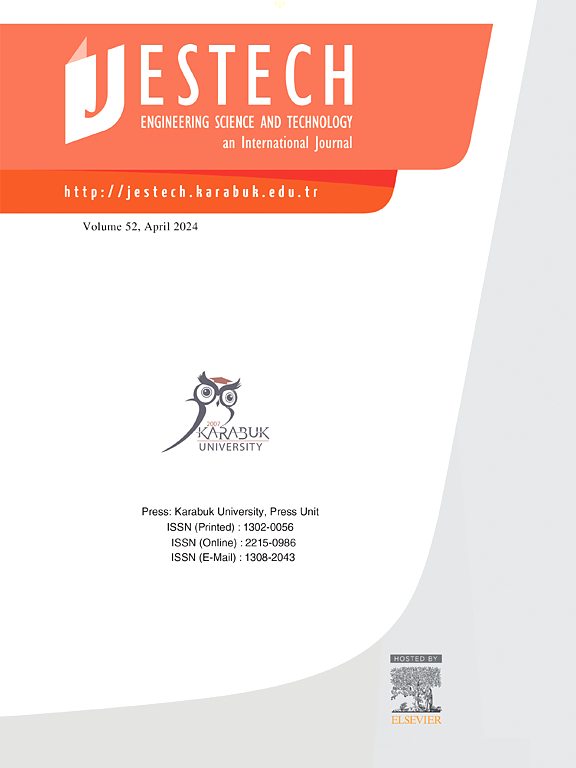Optimizing photovoltaic thermal systems with ternary hybrid nanofluids: Statistical and regression analysis
IF 5.4
2区 工程技术
Q1 ENGINEERING, MULTIDISCIPLINARY
Engineering Science and Technology-An International Journal-Jestech
Pub Date : 2025-02-28
DOI:10.1016/j.jestch.2025.102010
引用次数: 0
Abstract
This study explores the intricate interplay between ternary hybrid nanofluids and their impact on the electrical and thermal efficiencies of Photovoltaic Thermal systems (PV/T), considering a diverse range of nanomaterial shapes. It meticulously scrutinizes these systems within a structured framework, incorporating phase change materials and strategically positioned cylinders, leveraging advanced numerical methodologies for detailed analyses. This comprehensive investigation systematically amalgamates multiple nanomaterials and crucial parameters, offering invaluable insights into the optimization of PV/T performance within complex fluid dynamics and configurations. Examining the electrical and thermal efficiencies of the PV/T system using ternary hybrid nanofluids with nanomaterials suspended in variously shaped base fluids, this research involves a three-dimensional domain housing a rectangular block with a square base. This block integrates a phase change material (PCM), and its interior features four equally spaced circular cylinders regulating the flow of ternary hybrid nanofluids. Atop this block sits a PV panel comprised of glass, a silicon layer, and a copper absorber. The study incorporates three nanomaterials—multi-walled carbon nanotubes (MWCNT), alumina, and copper—suspended in water, each with unique shapes. These four cylinders are strategically positioned along the block’s length at 20 %, 40 %, 60%, and 80%, assuming the block’s height constitutes 20 % of its length. Utilizing the finite element method with the incompressible Navier-Stokes equations and heat equation in three dimensions, the investigation employs the conjugate heat transfer interface within COMSOL Multiphysics 6.0. It encompasses a broad array of numerical, statistical, and regression analyses to delve into the electrical, thermal, and phase transition characteristics of paraffin wax. The study scrutinizes four fundamental parameters: Reynolds number (ranging from 100 to 1000), total volume fraction of nanomaterials (ranging from 1 % to 10 %), shape factors (ranging from 3 to 5.7), and an aspect ratio (with the cylinder’s diameter-to-length ratio between 0.3 and 0.5). The present study reports an average electrical efficiency of 8.14 % for the PV/T system while achieving a maximum thermal efficiency of 71.62 %. Regression analyses indicate enhancements of 0.000008675, 0.00775855, and 0.00014403 in electrical efficiency per unit increase in Reynolds number, total volume fraction, and aspect ratio, respectively. Likewise, thermal efficiency shows improvements of 0.00000738889, 0.00482906, and 0.000118775 for one-unit increments in Reynolds number, volume fraction, and shape factor, respectively.
优化光伏热系统与三元混合纳米流体:统计和回归分析
本研究探讨了三元混合纳米流体之间复杂的相互作用及其对光伏热系统(PV/T)电效率和热效率的影响,考虑了各种纳米材料的形状。它在一个结构化的框架内仔细审查这些系统,结合相变材料和战略定位的圆柱体,利用先进的数值方法进行详细分析。这项全面的研究系统地整合了多种纳米材料和关键参数,为复杂流体动力学和配置下PV/T性能的优化提供了宝贵的见解。利用纳米材料悬浮在不同形状的基液中的三元混合纳米流体,研究了PV/T系统的电效率和热效率,该研究涉及一个具有方形基的矩形块的三维区域。该块集成了相变材料(PCM),其内部具有四个等间距的圆柱体,用于调节三元混合纳米流体的流动。在这个块体的顶部有一个由玻璃、硅层和铜吸收器组成的光伏板。该研究将三种纳米材料——多壁碳纳米管(MWCNT)、氧化铝和铜——悬浮在水中,每种材料都有独特的形状。假设砌块的高度占其长度的20%,40%,60%和80%,这四个圆柱体被策略性地放置在砌块长度的20%。采用COMSOL Multiphysics 6.0中的共轭传热界面,采用三维不可压缩Navier-Stokes方程和热方程的有限元方法进行研究。它包含了广泛的数值,统计和回归分析,深入到石蜡的电,热和相变特性。该研究仔细检查了四个基本参数:雷诺数(范围从100到1000)、纳米材料的总体积分数(范围从1%到10%)、形状因子(范围从3到5.7)和纵横比(圆柱体的直径与长度之比在0.3到0.5之间)。本研究报告PV/T系统的平均电效率为8.14%,而最大热效率为71.62%。回归分析表明,雷诺数、总体积分数和长径比单位增加的电效率分别提高了0.000008675、0.00775855和0.00014403。同样,雷诺数、体积分数和形状因子每增加一个单位,热效率分别提高0.00000738889、0.00482906和0.000118775。
本文章由计算机程序翻译,如有差异,请以英文原文为准。
求助全文
约1分钟内获得全文
求助全文
来源期刊

Engineering Science and Technology-An International Journal-Jestech
Materials Science-Electronic, Optical and Magnetic Materials
CiteScore
11.20
自引率
3.50%
发文量
153
审稿时长
22 days
期刊介绍:
Engineering Science and Technology, an International Journal (JESTECH) (formerly Technology), a peer-reviewed quarterly engineering journal, publishes both theoretical and experimental high quality papers of permanent interest, not previously published in journals, in the field of engineering and applied science which aims to promote the theory and practice of technology and engineering. In addition to peer-reviewed original research papers, the Editorial Board welcomes original research reports, state-of-the-art reviews and communications in the broadly defined field of engineering science and technology.
The scope of JESTECH includes a wide spectrum of subjects including:
-Electrical/Electronics and Computer Engineering (Biomedical Engineering and Instrumentation; Coding, Cryptography, and Information Protection; Communications, Networks, Mobile Computing and Distributed Systems; Compilers and Operating Systems; Computer Architecture, Parallel Processing, and Dependability; Computer Vision and Robotics; Control Theory; Electromagnetic Waves, Microwave Techniques and Antennas; Embedded Systems; Integrated Circuits, VLSI Design, Testing, and CAD; Microelectromechanical Systems; Microelectronics, and Electronic Devices and Circuits; Power, Energy and Energy Conversion Systems; Signal, Image, and Speech Processing)
-Mechanical and Civil Engineering (Automotive Technologies; Biomechanics; Construction Materials; Design and Manufacturing; Dynamics and Control; Energy Generation, Utilization, Conversion, and Storage; Fluid Mechanics and Hydraulics; Heat and Mass Transfer; Micro-Nano Sciences; Renewable and Sustainable Energy Technologies; Robotics and Mechatronics; Solid Mechanics and Structure; Thermal Sciences)
-Metallurgical and Materials Engineering (Advanced Materials Science; Biomaterials; Ceramic and Inorgnanic Materials; Electronic-Magnetic Materials; Energy and Environment; Materials Characterizastion; Metallurgy; Polymers and Nanocomposites)
 求助内容:
求助内容: 应助结果提醒方式:
应助结果提醒方式:


